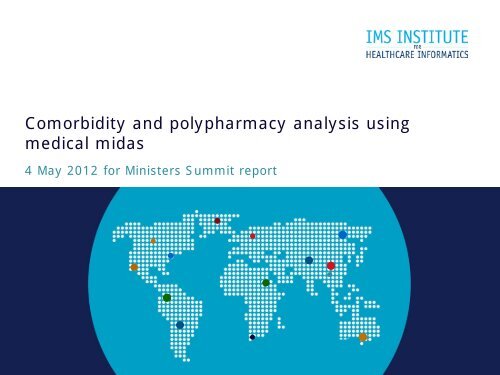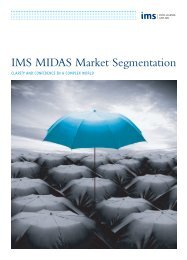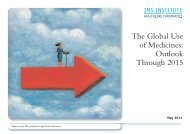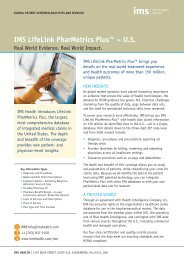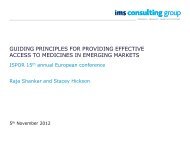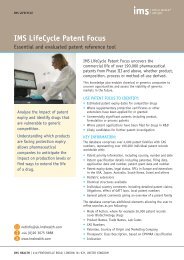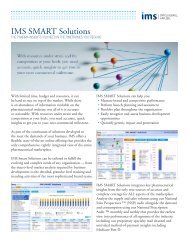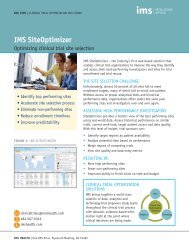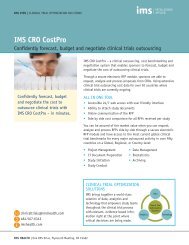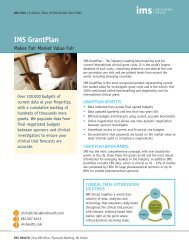Comorbidity and polypharmacy analysis using medical ... - IMS Health
Comorbidity and polypharmacy analysis using medical ... - IMS Health
Comorbidity and polypharmacy analysis using medical ... - IMS Health
Create successful ePaper yourself
Turn your PDF publications into a flip-book with our unique Google optimized e-Paper software.
<strong>Comorbidity</strong> <strong>and</strong> <strong>polypharmacy</strong> <strong>analysis</strong> <strong>using</strong><br />
<strong>medical</strong> midas<br />
4 May 2012 for Ministers Summit report
Noncommunicable diseases are prevalent across<br />
different countries <strong>and</strong> age groups<br />
Top 4 diseases for<br />
patients of 20-49 years old, 2011<br />
Top 4 diseases for patients of<br />
50+ years old, 2011<br />
• Respiratory<br />
• Genito-urinary<br />
• Musculoskeletal system<br />
• Mental <strong>and</strong> behavioural disorders<br />
• Hypertension<br />
• Diabetes<br />
• Musculoskeletal system<br />
• Respiratory<br />
Disease type<br />
Middle<br />
income<br />
countries<br />
High income<br />
countries<br />
Respiratory 10-13% 9-13%<br />
Genito-urinary 10-15% 6%*<br />
Respiratory 6-8% 7-10%<br />
Source: <strong>IMS</strong> Medical Midas data base from 6 countries, 2011 based on prescription data: France, Netherl<strong>and</strong>s, Australia,<br />
Colombia, Brazil <strong>and</strong> Indonesia<br />
*<strong>IMS</strong> data underestimates the value. Literature suggests that people above 40 have a higher risk of diabetes(see UK NHS<br />
website type 2 diabetes http://www.nhs.uk/Conditions/Diabetes-type2/Pages/Causes.aspx)
The number of patients diagnosed with at least two<br />
diseases increase by age, so does those multiple<br />
medicine intake<br />
% of patients with ≥ 2 diseases<br />
40<br />
35<br />
30<br />
25<br />
20<br />
15<br />
10<br />
5<br />
0<br />
20-34<br />
% of patients diagnosed with 2 or<br />
more diseases (out of patients with at<br />
least one), 2011<br />
35-49<br />
50-64<br />
Age b<strong>and</strong>s<br />
65+<br />
France<br />
Australia<br />
Egypt<br />
Indonesia<br />
Netherl<strong>and</strong>s<br />
Colombia<br />
Brazil<br />
% of population taking ≥5 medications<br />
0.5<br />
0.4<br />
0.3<br />
0.2<br />
0.1<br />
0.0<br />
% of patients over 50 years old taking<br />
5 or more concurrent medications,<br />
2011<br />
50-59<br />
60-69<br />
Age b<strong>and</strong>s<br />
70+<br />
France<br />
Indonesia<br />
Egypt<br />
Australia<br />
Netherl<strong>and</strong>s<br />
Colombia<br />
Brazil<br />
Source: <strong>IMS</strong> Medical Midas data base from 6 countries, 2011 based on prescription data: France, Netherl<strong>and</strong>s, Australia,<br />
Colombia, Brazil <strong>and</strong> Indonesia
Patients 60 years old are at high risk of major<br />
<strong>polypharmacy</strong><br />
Among adults >40 years old taking 5<br />
or more medicines, the majority are<br />
over 60 years old (%), 2011<br />
100%<br />
>60<br />
40-59<br />
• Of patients over 60 years old with<br />
double diseases, hypertension<br />
<strong>and</strong> diabetes are most prevalent<br />
comorbidities regardless of country<br />
types (income levels)<br />
• They are also most prevalent in<br />
patients with triple <strong>and</strong> quadrant<br />
diseases<br />
Australia<br />
Netherl<strong>and</strong>s<br />
France<br />
Brazil<br />
Egypt<br />
Indonesia<br />
Colombia<br />
Source: <strong>IMS</strong> Medical Midas data base from 6 countries, 2011 based on prescription data: France, Netherl<strong>and</strong>s, Australia,<br />
Colombia, Brazil <strong>and</strong> Indonesia


